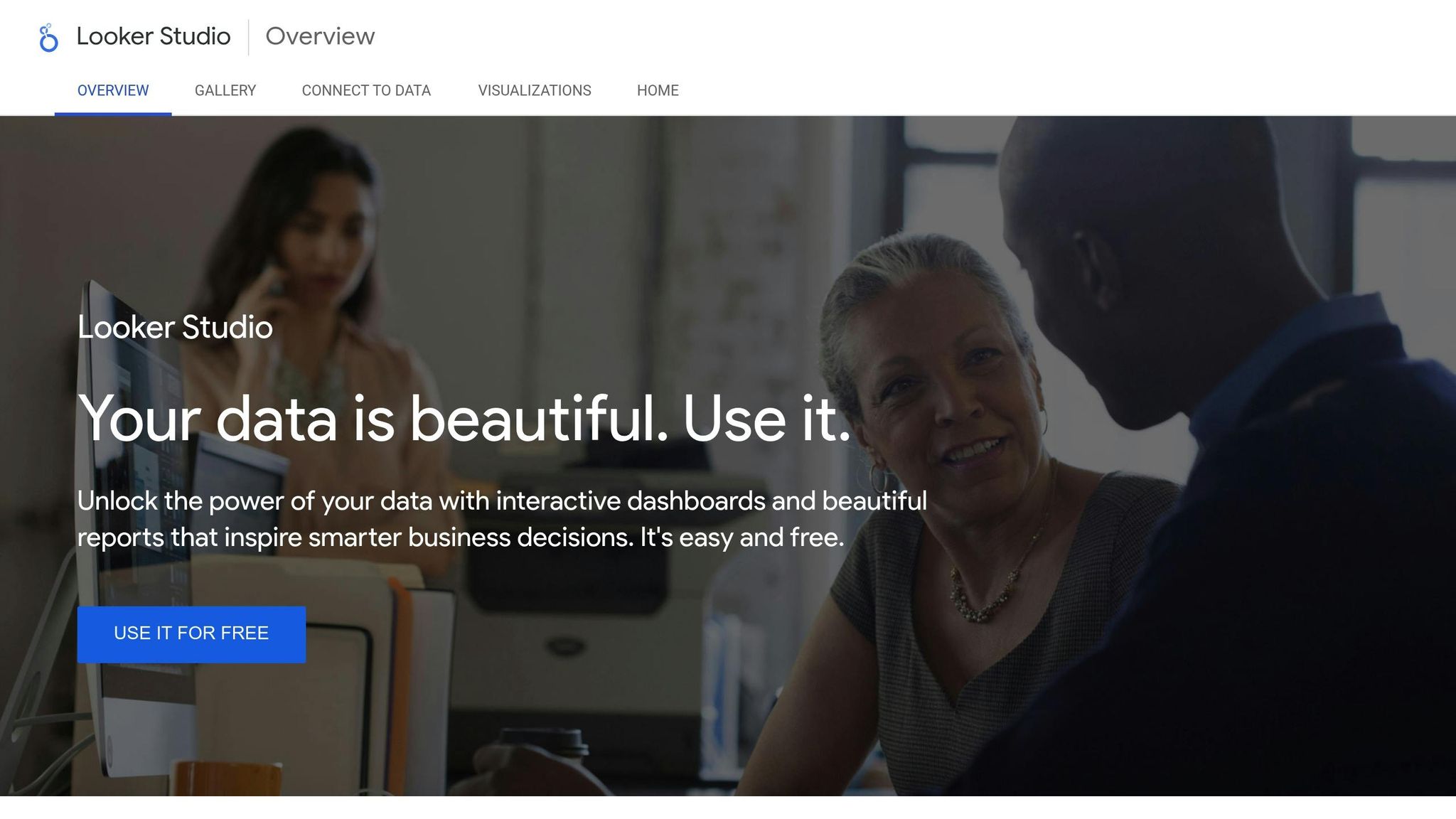Want to save time and improve your marketing decisions? Cross-platform reporting automation simplifies how businesses collect, process, and share data. Here’s what you’ll gain:
- Save time: Automation reduces reporting time by 40%.
- Cut costs: Prevent errors that could cost up to $878,000 annually.
- Boost accuracy: Eliminate manual errors for reliable insights.
- Track performance: Analyze data from multiple platforms in real-time.
- Make faster decisions: Access insights instantly to adjust strategies.
Tools like Google Looker Studio (free) and Supermetrics ($29/month) make it easy to get started. By automating workflows, you can focus on strategy while reports run themselves. Ready to streamline your reporting? Let’s dive in.
Getting Started with Reporting Automation
Choosing Data Sources and Setting Goals
Start by defining clear objectives and selecting reliable data sources. Did you know that about one-third of customer data becomes outdated every year? This makes it crucial to choose sources wisely to ensure your reports are accurate and actionable.
When evaluating data sources, keep these factors in mind:
- Data coverage and accuracy
- Real-time update capabilities
- Ease of integration
- Consistency and standardization of data
To set effective reporting goals, try using the "Who, Why, What" framework. Here's how it works:
| Framework Element | Key Considerations | Example |
|---|---|---|
| Who | Who will use the report? | Marketing team, executives, clients |
| Why | What’s the purpose? | Track ROI, optimize campaigns |
| What | What data is needed? | Conversion rates, ad spend, engagement |
Creating a Data Pipeline
A solid data pipeline is the backbone of reporting automation. Whether you use ETL (Extract, Transform, Load) or ELT (Extract, Load, Transform), the goal is to ensure your data flows seamlessly.
Here are the key steps to building an effective pipeline:
-
Data Quality Control
Before integrating data, implement strict validation processes. Standardize campaign names and establish clear data governance policies to maintain consistency. -
Choosing the Right Integration Method
Decide between ETL and ELT based on your specific needs. ETL transforms data before loading, while ELT is better suited for scalable cloud-based environments. -
Optimizing Performance
Improve pipeline efficiency by:- Using incremental updates to handle only new data
- Running parallel processes for multiple integrations
- Caching frequently used data for faster access
Once your pipeline is running smoothly, automate report scheduling to ensure timely delivery.
Setting Up Report Schedules
Scheduling reports effectively can make a big difference in productivity. For example, St Luke's University Health Network used report scheduling to identify bottlenecks and improve workflows.
To set up your schedules, focus on these steps:
- Define how often reports should run
- Set data refresh cycles to keep information current
- Automate report distribution to key stakeholders
- Establish alerts to flag any irregularities
"Real-time dashboards are great for those more savvy business owners or decision-makers who understand the need to look longitudinally at their marketing investment. The transparency always helps to strengthen long-term relationships."
– Bodie Czeladka, Creative & Managing Director at Dilate Digital
Top Tools for Report Automation
Popular Automation Software
Automated reporting tools have become a game-changer for businesses, helping streamline workflows and save valuable time. In fact, they can reduce reporting time by up to two hours per week per client.
| Tool | Key Features | Best For | Starting Price |
|---|---|---|---|
| Google Looker Studio | Data visualization, 800+ integrations, customizable dashboards | Teams needing free, all-in-one reporting | Free |
| Funnel.io | Marketing data foundation, advanced ETL capabilities | Enterprise-level data management | Custom pricing |
| Supermetrics | 75+ platform integrations, automated data collection | Marketing agencies | $29/month |
| Metrics Watch | Email-first analytics, white labeling options | Client reporting | $29/month |
Ronnel Viloria, Senior SEO Strategist at Thrive, highlights the value of Google Looker Studio:
"Google Looker Studio brings together the kind of advanced reporting features you'd expect from premium tools, all within a single, no-cost platform... It empowers users to handle their data with incredible precision, making it accessible for everyone from beginners to seasoned data analysts - without the extra financial burden."
Real-world success stories underscore the impact of these tools. For instance, Bath & Body Works saw a 30% boost in customer engagement and a 22% increase in online sales after adopting automated reporting tools.
If you're looking to simplify the selection process, specialized directories can also guide you.
Top PPC Marketing Directory Features
Directories like the Top PPC Marketing Directory bring together essential tools and insights for PPC advertising. They offer access to software that supports:
- Campaign and bid management
- Keyword research
- Ad copy optimization
- A/B testing
- Retargeting and remarketing
- Performance tracking
These directories provide a one-stop shop for advertisers to enhance their campaigns. A user of Emplifi explains the benefits:
"With Emplifi, we've been able to set more realistic KPIs, understand different metrics like engagement rate per reach or followers, and optimize campaigns more effectively. The platform has boosted our productivity by 40% by consolidating all data on a single platform, allowing us to pull comprehensive reports with just a few clicks."
When exploring tools through such directories, keep these considerations in mind:
- Integration Capabilities: Ensure the tools can seamlessly connect with your existing tech stack through robust API support.
- Customization Options: Look for solutions that offer flexibility in creating reports and dashboards tailored to your needs.
- Automation Features: Proper automation can drastically reduce reporting time - from several days to just about an hour per month.
Apostolos Tsiter, Product Owner at onvista, shares his experience with Metrics Watch:
"Metrics Watch was the only tool that met our requirements regarding both functionality and usability... The level of support and communication has made us true worshipers."
These tools and directories not only simplify reporting but also empower businesses to make data-driven decisions with ease.
Improving Your Automated Reports
Data Quality Control
Did you know poor data quality costs organizations a staggering $12.9 million annually? That’s why having a solid quality control process in place is non-negotiable.
Here’s how some industry leaders are tackling data quality issues:
-
Real-Time Validation: A global payment processor introduced automated error flags that:
- Prevented incorrect payments
- Reduced customer disputes
- Saved millions of dollars each year
-
Quality Control Systems: A telecommunications company implemented a system that:
- Cut customer complaints by 30%
- Reduced the need for manual data corrections
- Minimized reporting errors
Once your data is reliable, the next step is to turn it into reports that deliver clear, actionable insights.
Creating Custom Reports
Automation has made data collection faster and easier, but turning raw data into meaningful reports is where the real value lies. Custom reports should simplify complex information while aligning with your business goals.
"When it comes to marketing reports, it's all about keeping things simple! It's by far the biggest request we ever receive from clients. Keeping things simple doesn't mean excluding important data such as conversion and ROI statistics though. Ultimately, it's about explaining often complex data in a simple fashion."
Here are the core elements of an effective report and how to use them:
| Element | Purpose | Best Practice |
|---|---|---|
| Goals | Define objectives | Align with KPIs |
| Metrics | Measure performance | Focus on ROI |
| Visuals | Present data clearly | Use simple, clear charts |
| Context | Show performance trends | Compare year-over-year (YOY) |
| Commentary | Explain results | Add insights and narratives |
"Do not think of what we do as reporting data, but telling a story. What separates humdrum reports from memorable, practical insights is storytelling. The data in your reports, even beautifully presented with snappy graphics, is just a report until it's crafted into a real narrative. As a presenter of data, the job is to tell the user something about what you're showing, instead of just stating what you're showing."
Fixing Common Problems
Even the best reports can run into challenges during automation. When done right, automation can boost productivity by 20–25%. Here’s how to address common hurdles:
Data Security and Compliance
- Protect sensitive information with encryption, access controls, and regular audits.
System Performance
- Use automated monitoring tools with alerts and modular workflows to keep systems running smoothly.
"Don't give data without insight. Often, it's tempting to just pull a delivery report and send that off to a client, but that doesn't tell them anything. Our clients depend on us to look at the data and provide some insight into what the data means to their business."
sbb-itb-89b8f36
Google Looker Studio tutorial (2025): automate your marketing dashboards

What's Next in Report Automation
As reporting processes evolve, cutting-edge technologies are reshaping how businesses handle data, making reports faster, smarter, and more reliable.
AI Tools for Marketing Reports
AI is transforming report automation in a big way. By 2025, the global AI market is expected to hit $243.72 billion, with 92% of businesses planning to adopt generative AI tools within the next three years. The AI-driven marketing sector alone is projected to grow to $217.33 billion by 2034.
Here’s how AI is making an impact:
| AI Application | Effect |
|---|---|
| SEO Optimization | Improved search rankings for 65% of companies |
| Content Creation | Boosted marketing efficiency by 50% |
| Task Automation | Increased productivity by 43% |
| Personalization | Enhanced targeting for 73% of businesses |
One standout example is Harley Davidson’s use of Albert.ai in 2025. The results were impressive:
- A fivefold increase in website traffic
- A staggering 2,930% rise in monthly leads
- Smarter ad content optimized across multiple platforms
Clarke Boyd, Founder of Novela, highlights the importance of strategic thinking when leveraging AI:
"Advertisers are going to get these controls with AI, meaning that those with the greatest strategic thinking will get the most value. Those who can understand the data and the process behind creating the data will be able to get more value from things like performance max on Google."
While AI boosts performance and insights, blockchain technology is stepping in to ensure the data driving these insights remains secure and trustworthy.
Blockchain and Data Security
Blockchain is taking data security to the next level by offering decentralized storage, cryptographic protection, unchangeable records, and consensus-based verification. In 2023, only 0.34% of blockchain transactions were flagged as suspicious, showcasing its reliability.
IBM describes blockchain security as:
"A comprehensive risk management system for a blockchain network. It uses cybersecurity frameworks, assurance services and best practices to reduce risks against attacks and fraud."
To fully leverage blockchain’s potential, organizations should:
- Implement multi-factor authentication
- Regularly audit smart contracts
- Update security protocols frequently
- Conduct systematic risk assessments
Summary
Throughout this guide, we've highlighted how cross-platform reporting automation has become a game-changer for modern businesses. The numbers speak for themselves: companies see an average 32% revenue increase within a year of adopting marketing automation. The transformative potential is clear.
Here's a snapshot of what successful automation can achieve:
| Metric | Before Automation | After Automation | Improvement |
|---|---|---|---|
| Data Transfer Time | 4 hours | 2 hours | 50% reduction |
| Data Validation Errors | 10/week | 1/week | 90% reduction |
| Manual Intervention | 100% tasks | 10% tasks | 90% reduction |
| Financial Data Availability | Next day | Real-time | Real-time access |
Take Digitalfarm, for instance. Their success story underscores the efficiency gains made possible through automation. Karen Libao, Senior Social Media Manager Team Lead at Digitalfarm, shared:
"With Emplifi, we've been able to set more realistic KPIs, understand different metrics like engagement rate per reach or followers, and optimize campaigns more effectively. The platform has boosted our productivity by 40% by consolidating all data on a single platform, allowing us to pull comprehensive reports with just a few clicks."
To fully capitalize on automated reporting, organizations should focus on these key strategies:
- Centralize Data Governance: Ensure consistent and high-quality data across platforms.
- Enable Real-time Monitoring: Quickly identify and address potential issues.
- Validate Regularly: Double-check automated processes against original data sources.
- Invest in Training: Equip your team to make the most of automation tools.
- Collaborate with Experts: Bring in consultants to apply best practices effectively.
Looking ahead, automation will continue to advance while prioritizing security and accuracy. BILL's automation capabilities provide a great example of this balance. Cassidy Jakovickas, president and CEO of MBS Accountancy, explains:
"BILL's automation capabilities provide much-needed transparency, acting like a third party by keeping an eye on things, sending reminders, and moving the approval process forward to the next reviewer. Each step is tracked and audit-ready as every payment is looked at before it leaves."
Considering marketers spend 20% of their work hours on reporting tasks, automation offers a real chance to reclaim time for strategic and creative initiatives.
FAQs
What’s the difference between ETL and ELT, and how do I decide which one is best for my reporting needs?
ETL (Extract, Transform, Load) and ELT (Extract, Load, Transform) are two distinct approaches to managing data, differing mainly in the timing and sequence of transformations.
With ETL, data is transformed before it's loaded into a data warehouse. This makes it a solid choice for structured datasets and environments where compliance and data quality are critical. It's particularly effective for smaller datasets or systems that require clean, prepared data right from the start.
ELT, on the other hand, takes a different route. It loads raw data directly into a data lake or cloud storage, with transformations happening afterward. This method shines when working with massive datasets, enabling real-time analytics and taking full advantage of the scalability offered by modern cloud platforms.
Deciding between the two depends on your specific needs. If you're dealing with legacy systems or require precise transformations upfront, ETL is likely the better option. For large-scale, flexible data processing with minimal initial transformation, ELT is the way to go.
How can businesses maintain accurate and reliable data when automating cross-platform reports?
To keep data accurate and dependable in automated cross-platform reports, businesses need solid data quality practices. This means leveraging tools that can automatically validate, monitor, and clean data, reducing the need for constant manual checks.
Some important steps include defining clear validation rules, conducting regular audits, and using real-time monitoring to quickly identify and fix errors. On top of that, having a well-defined data governance framework - with clear roles and responsibilities - helps ensure data inputs remain consistent and reliable across different platforms. Taking these proactive measures not only enhances data accuracy but also strengthens trust in your reports and decision-making.
How do AI and blockchain technologies improve reporting automation, and what are the benefits for data security and insights?
AI and blockchain are reshaping reporting automation by boosting efficiency, strengthening data protection, and offering more in-depth insights. AI plays a key role in processing and analyzing massive datasets quickly and accurately. This allows marketers to predict trends, pinpoint customer segments, and make informed decisions to fine-tune campaigns and strategies.
Meanwhile, blockchain adds a layer of security with its decentralized, tamper-resistant ledger system. It's particularly effective for verifying transactions and safeguarding sensitive data, significantly cutting down the chances of fraud. When combined, AI and blockchain offer a blend of insightful analytics and strong security measures, empowering organizations to make smarter choices while keeping their data safe.


